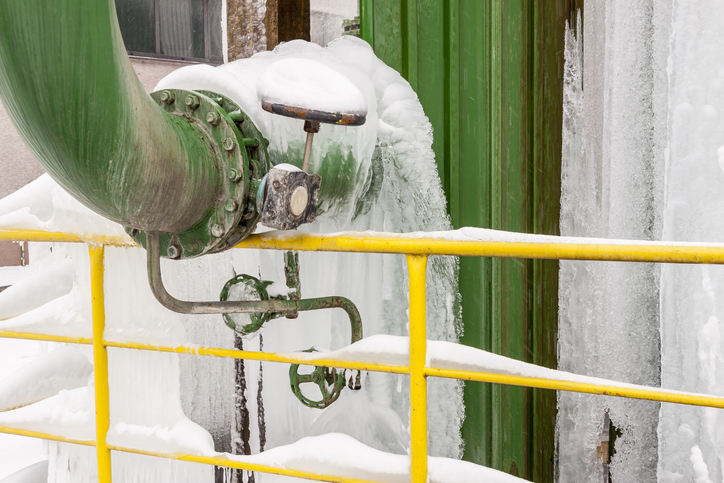Protecting Against Frozen Pipes & Sprinkler Systems
Posted January 24, 2024

Where Are Pipes and Sprinkler Systems Most at Risk of Freezing?
Pipes and sprinkler systems are most exposed to freezing in areas of a building or property where temperatures can drop significantly during cold weather. The vulnerability to freezing depends on the specific location and environmental conditions. Here are the most common areas where pipes and sprinkler systems are highly exposed to freezing:
- Exterior walls—Pipes located near or within exterior walls are particularly vulnerable. These walls are exposed to the outdoor elements; when temperatures plummet, the cold can penetrate the walls and affect the pipes within.
- Ceiling voids—Ceiling voids are often poorly insulated and may lack heating. As a result, any pipes in the ceiling void can be exposed to freezing temperatures, especially in regions with severe winters.
- Basements and crawl spaces—Basements and crawl spaces are typically cooler than the rest of the building, so pipes may not receive sufficient heat.
- Utility rooms—Rooms housing water heaters, boilers and other plumbing components can be prone to freezing if not adequately heated.
- Exterior pipelines—Outdoor pipelines, including those used for landscaping, irrigation or fire protection, are exposed to the elements. If not properly insulated or protected, they can freeze in cold weather.
- Unheated storage areas—Unheated storage areas, such as warehouses or storage rooms, often lack sufficient heating. Any pipes in these spaces are at risk of freezing when temperatures drop.
- Roof—In some commercial and industrial buildings, roof-mounted sprinkler systems are installed for fire protection. Due to their location on the roof, where cold winds and precipitation can impact them, these systems can be exposed to freezing temperatures.
What Impact Can Frozen Pipes and Sprinkler Systems Have on Businesses?
The freezing of essential building infrastructure components like pipes and sprinkler systems can significantly impact your business, leading to a range of negative consequences that affect operations, finances and safety. Here are the key impacts of frozen pipes and sprinkler systems:
- Disruption of operations—Frozen pipes can cause leaks, leading to water supply shutdown and disruptions in day-to-day operations.
- Property damage—Burst pipes and malfunctioning sprinkler systems can cause costly water damage to a building’s structure, interior and equipment.
- Safety risks—Frozen pipes can cause leaks, flooding and slip-and-fall hazards. Water damage can also create electrical hazards. Further, malfunctioning sprinklers can be dangerous during a fire emergency.
- Loss of reputation and customer trust—Businesses that experience disruptions or safety incidents due to frozen pipes or sprinkler systems may suffer reputational damage. Customers and clients may lose trust in the company’s ability to maintain a safe and reliable facility.
- Regulatory and compliance issues—Certain industries and regions have specific regulations and codes related to fire protection systems. Failure to maintain a functional sprinkler system can result in legal compliance issues, fines and penalties.
- Increased insurance costs—Businesses affected by frozen pipes or sprinkler systems may need to file insurance claims to cover repair and restoration costs. This can lead to increased insurance premiums in the future.
- Operational inefficiency—Addressing the aftermath of frozen pipes and sprinkler system issues can divert resources away from regular business activities, leading to inefficiencies.
Steps to Minimize the Risk of Frozen Pipes and Sprinkler Systems
To reduce the risk of freezing pipes and sprinkler systems, businesses can take several preventive measures. The following steps can help protect the integrity of their infrastructure, avoid costly damage and maintain the functionality of fire protection systems:
- Insulate pipes. Insulate pipes in unheated or exposed areas with pipe insulation sleeves or heat tape to prevent freezing. Check the insulation for deterioration.
- Seal gaps and cracks. Inspect the building for gaps, cracks and openings that allow cold air to enter. Seal these areas to prevent drafts that can affect the temperature of pipes.
- Maintain adequate heating. Ensure that spaces containing pipes are properly heated, especially in areas with exposed pipes. Consistent heating prevents freezing. Monitor the heating system to ensure proper function and maintain suitable temperature in vulnerable areas.
- Drip faucets. During extremely cold weather, allow faucets to drip slowly. Running water is less likely to freeze, reducing the risk of burst pipes.
- Protect sprinkler systems. To prevent the freezing of sprinkler pipes, insulate or use heat tape in susceptible areas. Hire a professional to ensure proper installation. Consider using antifreeze solutions designed for fire protection systems.
- Conduct regular inspections. Schedule routine inspections of your plumbing and sprinkler systems, particularly before the winter season. Identify and address issues early to prevent more significant problems.
- Prepare for emergencies. Create an emergency plan for frozen pipes or sprinkler malfunctions. Educate employees on the protocol to minimize damage. Keep contact information of professionals for immediate assistance.
- Watch the weather. Stay informed on weather forecasts, especially during cold spells. Take extra precautions when extremely low temperatures are expected.
- Train employees. Train employees on how to identify signs of freezing pipes or sprinkler system issues and make sure they know how to shut off the water supply in case of an emergency.
- Monitor exterior systems. If your business has exterior sprinkler systems for landscaping or fire protection, monitor and winterize them properly. This may involve draining the systems or implementing other protective measures to prevent freezing.
- Use frost-resistant materials. When installing new plumbing or sprinkler system components, consider using frost-resistant materials that are less prone to freezing.
Conclusion
It is crucial to protect your business from frozen pipes and sprinkler systems to prevent expensive damage and maintain business operations during the winter season. By identifying areas that are vulnerable, understanding the impact of cold weather on pipes and implementing preventive measures, you can protect your business, ensure the safety of your employees and safeguard your assets.
Contact Horst Insurance today for more information.
